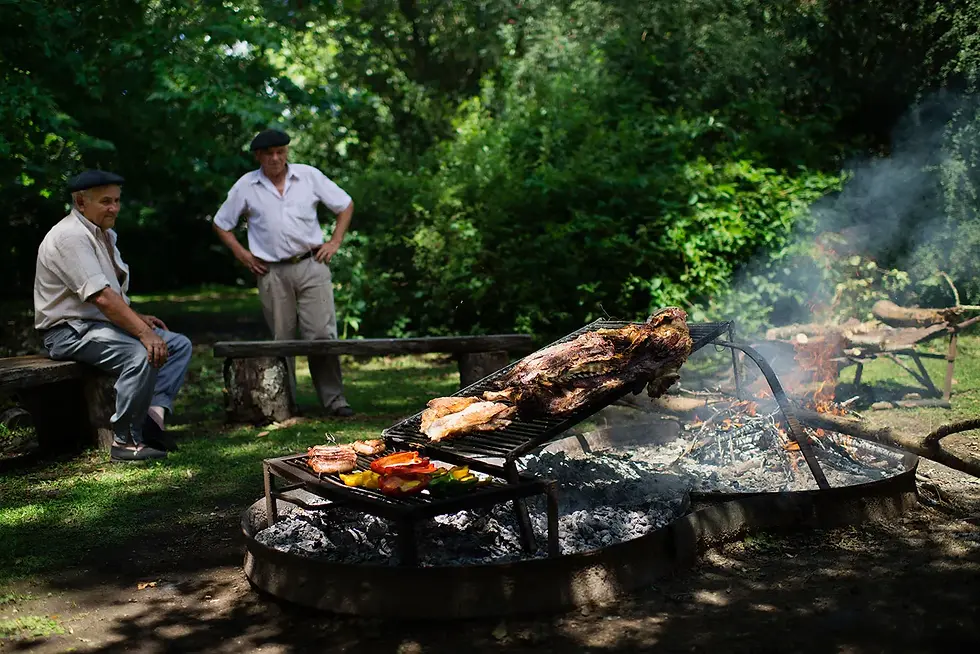The Argentinian Asado: A Tradition of Fire, Flavor, and Friendship
- The Epicurer

- 13 jun
- 3 Min. de lectura
In Argentina, the asado is more than just a way to cook meat—it's a way of life. From the windswept Pampas to the high-rise balconies of Buenos Aires, the scent of wood smoke and sizzling beef is woven into the cultural fabric. On Sundays, during holidays, or even after a long workweek, families and friends gather around the parrilla not simply to eat, but to share in a ritual that feels sacred and entirely Argentine.
The tradition of the asado began centuries ago with the gauchos—the rugged, nomadic horsemen of the grasslands—who cooked the abundant local cattle over open fires. With nothing but salt and time, they transformed simple meat into something profound. That simplicity still defines the asado today. It’s about honoring the ingredient, the process, and the people around the fire.
To be invited to an asado is to be welcomed into a circle. It starts slowly, as all good things should. The fire is lit hours before the first bite, often with hardwoods like quebracho or algarrobo, chosen for the steady embers they provide. The host—usually a seasoned asador—tends to the flames with the kind of quiet confidence passed down from one generation to the next. He or she doesn’t rush. The fire dictates the pace, and everyone else falls into rhythm with it.

As the coals grow hot and glowing, the meat is arranged on the grill. There’s a natural order to the cuts: chorizo and morcilla (blood sausage) go on early and are often the first to be served as appetizers, sometimes alongside provoleta—grilled provolone cheese drizzled with oregano and olive oil until it melts into golden bliss. Then come the heavier cuts: ribs, flank steak, short ribs, sweetbreads, and occasionally chinchulines (intestines), crackling at the edges. Each piece is handled with care, seasoned only with coarse salt, and cooked slowly, never directly over flame. Patience is the key ingredient.
But asado isn’t just about what’s on the grill. It’s about the time spent waiting. People stand around the parrilla, sipping glasses of Malbec or fernet and Coke, telling stories, debating football, or just enjoying the moment. The fire becomes the gathering point—warm, fragrant, and inviting. Children run around, someone puts on music, and conversations stretch long into the night.
When the meat is ready, it’s served in rounds, laid out on wooden boards or passed from hand to hand. There’s no formal sitting—just bites shared over laughter and full glasses. Chimichurri and salsa criolla sit in bowls for those who want a touch of acid and herbs, but the meat stands on its own. No heavy sauces, no gimmicks—just quality beef, fire, and time.
In cities, where space is tighter, Argentinians build parrillas on balconies, rooftops, or even in small courtyards. In rural areas, asados sprawl under trees and sky, lasting all day. Though modern life shifts and changes, the asado remains a constant—a pause button in a fast world.

In recent years, the tradition has evolved to embrace new voices. Vegetarians now join the circle with grilled provoleta, eggplant, and mushrooms. Women are increasingly stepping into the role of asador. But the core never changes: the asado is about gathering, sharing, and respecting both the food and the people you’re with.
It’s not surprising that Argentina is fiercely proud of this tradition. UNESCO has recognized it as part of the country’s intangible cultural heritage, and rightly so. The asado is a celebration—not just of beef or grilling skill, but of friendship, time, and the simple magic of eating together.
In Argentina, to eat an asado is to be home—even if you’re just visiting.



